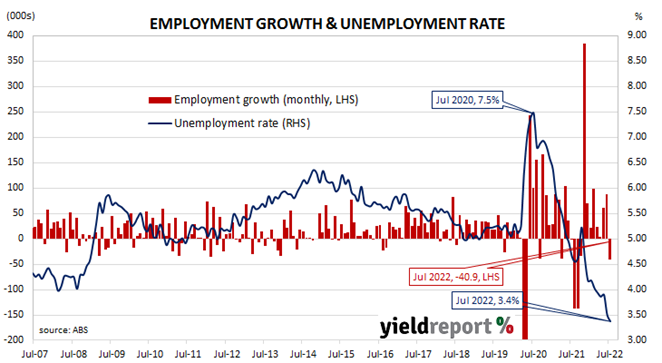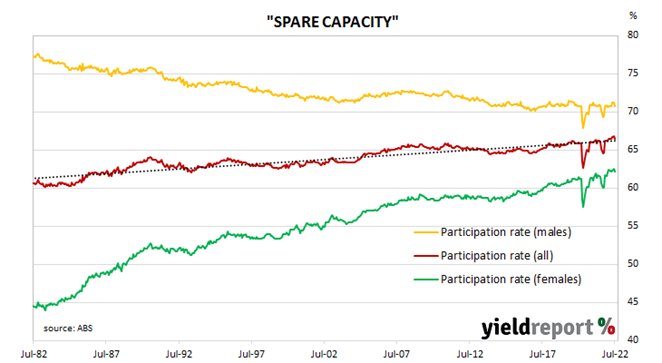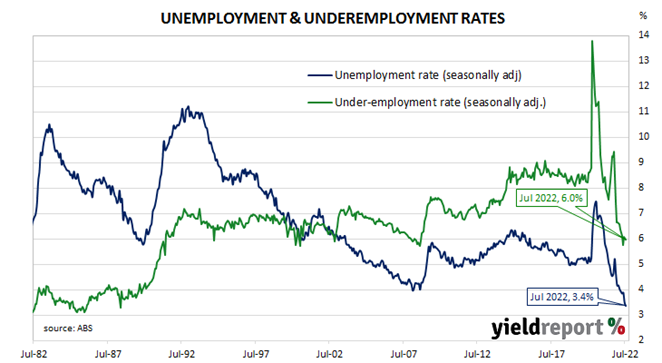Summary: Employment down 40,900 in July, contrasts with expected 25,000 gain; employment still 108,000 higher than three months ago; worker absenteeism linked to COVID, influenza season “keenly felt”; participation rate falls back from record high; jobless rate falls to 3.4%; more part-time, fewer full-time jobs; aggregate work hours down 0.8%; underemployment rate down from 6.1% to 6.0%.
Australia’s period of falling unemployment came to an end in early 2019 when the jobless rate hit a low of 4.9%. It then averaged around 5.2% through to March 2020, bouncing around in a range from 5.1% to 5.3%. Leading indicators such as ANZ’s Job Ads survey and NAB’s capacity utilisation estimate suggested the unemployment rate would rise in the June 2020 quarter and it did so, sharply. The jobless rate peaked in July 2020 but fell below 7% a month later and has since trended lower.
The latest Labour force figures have now been released and they indicate the number of people employed in Australia according to ABS definitions decreased by 40,900 in July. The fall contrasted with the 25,000 increase which had been generally expected and June’s 88,400 rise.
“Employment is still 108,000 higher than it was three months ago and, given that a huge volume of unfilled labour demand remains, we think employment will return to strong growth over the remainder of this year,” said ANZ senior economist Catherine Birch. “We still expect the unemployment rate to fall into the high-2s by early 2023.”
Domestic Treasury bond yields rose moderately on the day. By the close of business, the 3-year ACGB yield had gained 5bps to 3.12%, the 10-year yield had added 6bps to 3.35% while the 20-year yield finished 5bps higher at 3.68%.
In the cash futures market, expectations of higher rates firmed. At the end of the day, contracts implied the cash rate would rise from the current rate of 1.81% to 2.16% in September and then increase to 2.895% by November. May 2023 contracts implied a 3.56% cash rate, as did August 2023 contracts.
“The side effects of continued worker absenteeism linked to COVID and [the] influenza season was keenly felt with around 750,000 people impacted, double the usual number,” said Morgan Stanley Australia economist Chris Read. He also noted the survey period had coincided with winter holidays and ongoing flood impacts in New South Wales.
The participation rate fell back from June’s record-high figure of 66.8% to 66.4% as the total available workforce decreased by 61,200 to 14.032 million while the number of unemployed persons decreased by 20,300 to 473,600. As a result, the unemployment rate declined from 3.5% to 3.4% as the lower jobless number outweighed fewer people in the workforce.
The aggregate number of hours worked across the Australian economy decreased as 46,000 residents gained part-time positions and 86,900 residents lost full-time positions. In percentage terms, the total number of work hours fell by 0.8% after remaining steady in June. On a 12-month basis and after revisions, aggregate hours worked increased by 3.4% as 5,700 more people held part-time positions and 392,900 more people held full-time positions than in July 2021.
In recent years, more attention has been paid to the underemployment rate, which is the number of people in work but who wish to work more hours than they do currently. July’s underemployment rate declined from 6.1% to 6.0%, 0.3 percentage points above May’s recent low of 5.7%.
The underutilisation rate, that is the sum of the underemployment rate and the unemployment rate, has a strong correlation with the annual growth rate of the ABS private sector wage index when advanced by two quarters. July’s underutilisation rate of 9.4% corresponds with an annual growth rate of about 4.7%.




